Well, here’s some stuff for thought. I’m going to be all over the place here. With Scotland, China, the United States, food, girls, and being a Rufus all thrown together to make a disjointed point about being a human and showing humanity. So enjoy my ramblings and take a nice stroll in MM land here today. I hope you all enjoy it.
We start off with America
America’s Judges Are Putting My Life on the Line
Sara Nelson [New York Times, via Naked Capitalism 11-12-2021]
America needs more judges who understand and support the rights of workers. For too long, the courts have sided with corporations over labor, fundamentally and perniciously reshaping American law, life and liberty. Today, they are doing their part to unravel the American dream — and the social contract that has been in place since the 1940s, offering the working class a good life if they spend 40 hours on the job, the means to enjoy it in off hours and a secure retirement. In one stark example, a judge in Alabama in October barred union mineworkers from picketing within 300 yards of mine entrances, even as the authorities there have failed to charge the drivers of vehicles that struck lawful picketers. In a more common infringement of free speech, a judge in Iowa limited United Auto Workers picket lines outside a John Deere plant in Davenport last month to just four people at each entrance to the plant…. This didn’t happen by accident. Republican presidents have stacked the federal courts with judges who hail from elite law schools, white-shoe law firms and corporate boardrooms. (More than a quarter of all federal judges on the bench in January had been appointed by Donald Trump.) As a result, the corporate win rate in American courts is sky-high. This is especially true in cases heard by the Supreme Court, which has sided with the Chamber of Commerce 70 percent of the time since 2006. A study published in 2013 ranked Chief Justice John Roberts and Justices Samuel Alito and Clarence Thomas among the five most-corporate-friendly members of the court since 1946, and the pro-corporate voting rate of its conservative wing is only growing. According to one recent report, the court agrees with the Chamber of Commerce more now than it had at any other time in recent history…. This isn’t just an academic question, or even an economic one — it’s often a matter of life and death. Before he joined the Supreme Court, Neil Gorsuch, as a judge on the Court of Appeals for the 10th Circuit, voted to allow the firing of an employee who abandoned an unheated company truck in a blizzard to avoid freezing to death. This is just one example of the judicial callousness toward workers that has put our livelihoods and lives in real danger.
How Other Nations Pay for Child Care. The U.S. Is an Outlier.
[New York Times, October 6, 2021, via The Big Picture 11-7-2021]Rich countries contribute an average of $14,000 per year for a toddler’s care, compared with $500 in the U.S. GRAPH
The truth HURTS. Exceptional, my ass!
The carnage of mainstream neoliberal economics
Yves Smith, November 10, 2021 [Naked Capitalism]
Broken chain of supply
[Business Insider, via The Big Picture 11-7-2021] A second tour of the The Ports of Los Angeles and Long Beach. “‘I blame 150 years of supply chain optimization,’ Nathan Strang, Flexport’s director of ocean trade lane management, told Insider of why ships are still steaming towards Los Angeles and Long Beach. ‘It’s a sign of their success, that’s causing the congestion.’” ….the ports can’t just stack up the containers until a driver comes to pick them up: “There’s no space,” Rice said…. “A lot of the congestion is due to the fact that there’s nowhere to put the empty containers.” Flexport’s Strang said. “Having some way to get those empties stored and off the chassis so that we can pick up live containers, that would actually go very far.”
American GREED. Stop blaming China.
How American leaders failed to help workers survive the ‘China Shock’
[NPR, via The Big Picture 11-7-2021]But most economists, like most American leaders, had believed that workers would adapt somewhat smoothly to economic change and that they would find solid places to work in other sectors. “We had this notion that the American economy is this incredibly dynamic place,” says Hanson, an economist at Harvard Kennedy School. “We create millions of jobs every year, and we destroy millions of jobs every year. We thought we could handle moving a couple of million manufacturing workers from one sector to another.” Autor, Dorn and Hanson’s first peer-reviewed papers from their China Shock saga were published in 2013. The economists found that between 1990 and 2007, trade with China killed about 1.5 million American manufacturing jobs, or about a quarter of all manufacturing jobs lost during that period. But what was even more startling: These losses were heavily concentrated in small- and medium-size communities dotting America’s heartland — and workers who lost their jobs in those areas struggled to find other work. The China Shock created what looked like miniature Great Depressions in these places. Standard economic theory said that the non-college-educated workers who lost their jobs would move or retrain and find work in other places or sectors. But they didn’t. Most stayed put and were never fully employed again. “It ended up creating these pockets of distress,” Hanson says. “That was the surprising part. That’s what we economists didn’t know was going to happen.”
As Treasury Secretary Alexander Hamilton wrote in 1791:
Experience teaches, that men are often so much governed by what they are accustomed to see and practice, that the simplest and most obvious improvements, in the [most] ordinary occupations, are adopted with hesitation, reluctance and by slow gradations … To produce the desirable changes, as early as may be expedient, may therefore require the incitement and patronage of government…
Too bad Hamilton is not required reading for economics students…
Bill Mitchell — When labour shortages just signal management caprice
I have been researching the so-called labor shortage that business types are talking about relentlessly as part of their on-going strategy to undermine the conditions of work and make more profit. In the course of that inquiry, I came across an interesting juxtaposition between two US companies that illustrate a lot of what we have known about for years but have allowed this relentless, neoliberal, race-to-the-bottom to obscure. Well-paid workers with job security, work better and are happy workers. Companies that pursue the ‘race-to-the-bottom’ strategy and seek to build profits by trashing the conditions they offer workers eventually struggle to prosper because their bad reputation undermines their ability to attract productive workers. In the case we discuss today, the so-called ‘labor shortage’ is really just a signal of management caprice. Rather than being a shortage of workers, there is a shortage of workers who will tolerate the indignity of low wages, onerous conditions and capricious management. It is also a union versus non-union type of discussion where the unionised work places generate high productivity and worker attachment, while the non-unionised workplaces find it hard to attract reliable staff and blame it all on ‘labor shortages’….
It’s all over the “West”. The capitalist democracies are all falling apart.
They’re not capitalists – they’re a criminal predatory class
[International Consortium of Investigative Journalists, via Mike Norman Economics 11-10-2021]No shit! Dick Tracy.
David Dayen, November 12, 2021 [The American Prospect]
A new report identifies 20 major corporate recidivists, with rap sheets that should be in the sights of the Justice Department’s new approach to white-collar crime.
Pam Martens and Russ Martens: November 12, 2021 [Wall Street on Parade]
Pam Martens and Russ Martens: November 10, 2021 [Wall Street on Parade]
Pam Martens and Russ Martens: November 9, 2021 [Wall Street on Parade]
As for leverage at hedge funds, yesterday’s Fed report had this to share: “Hedge fund leverage remained somewhat higher than its historical average in the first quarter of 2021, according to the most comprehensive available measures. On-balance-sheet leverage at hedge funds, based on confidential data collected by the Securities and Exchange Commission (SEC), decreased in the first quarter to a level close to its historical average. Gross leverage at hedge funds—based on the same source but including off-balance-sheet derivatives exposures—continued to be above its historical average in the first quarter.” One needs to carefully parse the above paragraph. Why does the Federal Reserve, which has bank examiners in every mega bank that owns a trading house on Wall Street, need to ask the SEC for data about hedge fund leverage? The prime brokerage operations of those mega banks are the ones making those highly leveraged loans to hedge funds. (See our report: Archegos: Wall Street Was Effectively Giving 85 Percent Margin Loans on Concentrated Stock Positions – Thwarting the Fed’s Reg T and Its Own Margin Rules.)
Climate and environmental crises
[Twitter, via Naked Capitalism Water Cooler 11-12-2021]Take a look at who actually emits the most carbon. And take a look at how much rich people in the US emit, compared to absolutely anyone else https://t.co/XGjRhj1OKE pic.twitter.com/UbNjGlx9Ld
— Vincent Bevins (@Vinncent) November 8, 2021
Yeah blame China, instead of looking at yourselves.
[Financial Times, via Tweet above]The fight to protect the planet is shifting in ways that could soon exacerbate conflicts within countries, particularly between social classes. Or, to put it bluntly, between the rich and the rest. The top 1 per cent by income of the world’s population account for about 15 per cent of emissions, according to UN data. That is more than double the share of the bottom 50 per cent.
[Digg, via Naked Capitalism 11-13-2021] [Slate, via The Big Picture 11-10-2021]The challenge is not identifying the solutions, but rolling them out with great speed.[South China Morning Post, via Naked Capitalism Water Cooler 11-11-2021]
“The Iceland plant, called Orca, is the largest such facility in the world, capturing about 4,000 metric tonnes of carbon dioxide per year. But compared to what the planet needs, the amount is tiny. Experts say 10 billion tonnes of carbon dioxide must be removed annually by mid-century…. Leading scientific agencies including the United Nations Intergovernmental Panel on Climate Change say that even if the world manages to stop producing harmful emissions, that still won’t be enough to avert a climate catastrophe. They say we need to suck massive amounts of carbon dioxide out of the air and put it back underground – yielding what some call “negative emissions”… As dire warnings have accelerated, technology to vacuum carbon dioxide from the air has advanced. Currently, a handful of companies operate such plants on a commercial scale, including Climeworks, which built the Orca plant in Iceland, and Carbon Engineering, which built a different type of direct air capture plant in British Columbia. And now that the technology has been proven, both companies have ambitions for major expansion. At Climeworks’ Orca plant near Reykjavik, fans suck air into big, black collection boxes where the carbon dioxide accumulates on a filter. Then it’s heated with geothermal energy and is combined with water and pumped deep underground into basalt rock formations. Within a few years, Climeworks says, the carbon dioxide turns into stone.”[Pro Publica, via Naked Capitalism Water Cooler 11-11-2021]
“ProPublica’s analysis of five years of modeled EPA data identified more than 1,000 toxic hot spots across the country and found that an estimated 250,000 people living in them may be exposed to levels of excess cancer risk that the EPA deems unacceptable. The agency has long collected the information on which our analysis is based. Thousands of facilities nationwide that are considered large sources of toxic air pollution submit a report to the government each year on their chemical emissions. But the agency has never released this data in a way that allows the public to understand the risks of breathing the air where they live. Using the reports submitted between 2014 and 2018, we calculated the estimated excess cancer risk from industrial sources across the entire country and mapped it all.”
Creating new economic potential – science and technology
[Bloomberg, via Naked Capitalism 11-9-2021] [MIT Technology Review, via Naked Capitalism 11-11-2021] [Brighter Side, via Naked Capitalism 11-13-2021]- Information Age Dystopia
Securing your digital life, part one: The basics
[ars technica, via Naked Capitalism 11-13-2021]Collapse of Independent News Media
David Sirota [The Daily Poster, November 8, 2021]
This morning, the New York Times published a screed from pollster Mark Penn and former New York City lawmaker Andrew Stein demanding Democrats abandon their promised agenda ahead of the midterm elections. The massive 1,500 word op-ed — designed to define the political news cycle for the coming week — echoes a house editorial from the newspaper making much the same argument, and it mirrors previous Penn diatribes that the Times has platformed in the past. In the process, this essay offers a rare glimpse of how corporate media imperceptibly puts its thumb on the scale for a particular ideology that is decidedly neither centrist nor objective. The Times’ original headline on Monday’s piece (which has since been changed) read “A Way Forward for Biden and the Dems in 2022 & 2024.” It argues that President Biden should “listen to centrists (and) push back on the left” and insists Sens. Joe Manchin and Kyrsten Sinema “are in fact the very heart of the Democratic Party.” It’s a hot take that might be mildly interesting, if it came from voices who genuinely had the Democratic Party’s best interests in mind. However, the Times decided to not tell readers that Penn is a private equity mogul with myriad connections to the corporate world that’s looking to kill the Democratic legislative agenda that the op-ed seeks to curtail. The paper doesn’t mention Penn’s ties to No Labels, a dark money group funded by big donors that’s been vilifying Democrats’ reconciliation bill. The paper also declines to mention that Penn advised President Donald Trump during his first impeachment, nor does it mention that Stein is the guy who
The Windows XP wallpaper is now a vineyard

Ammonia-based fertilizers
Ammonia-based fertilizers are made from nitrogen (it’s most of our air, so never in short supply) and natural gas or methane (CH4), and make up almost 70% of all fertilizers used world-wide to support major agriculture crops such as wheat, corn, rice and even coffee. As natural gas prices have soared by anywhere from 300% to 500% over the past months, this has had a devastating impact on world fertilizer production, where some 80% of the cost of making ammonia fertilizers is due to the natural gas cost.
What’s more, big Ammonia plants in many countries are now closing (for how long?), and China, who is said to make 30% of the world supply of ammonia, has just banned its export. (Check to verify). Early next year this will all become very evident. First hit will be animal feed so it looks like meat eating will diminish greatly. I don’t see any way it won’t happen.
https://journal-neo.org/2021/11/12/now-the-organized-takedown-of-global-fertilizer-supply/
Here’s Guangzhou, China.
It’s a very middle class city. Full of factories and just blue-collar Chinese people. Check it out. Video.
“Where’s Waldo” Beach addition for warmer wallpaper weather!

Some stuff on China
From the Daily Stormer…
Since Biden has taken over, there have been nonstop threats against China, and US warplanes and warships are racing in and out of their territories. Biden’s Secretary of Defense flew to Japan to demand that they sign a blood pact to defend Taiwan. Most of the US military activity is not much reported on in the American media (I usually read about it on RT), but we are hearing rising nonsense about the poor and pitiful Moslems, and the importance of Americans devoting their military to defending the sacred democracy of the very important nation of Taiwan.
What is incredible to me is that both the right and the left are so easily manipulated into thinking conflict with China is a good idea. For the left, I guess it makes sense. As we’ve mentioned before, the Antifa type neo-socialists who have been so heavily force-memed on social media as the Democrat Party’s internet defense force (Vaush, for example) spend a lot of time talking about how China is a “fascist state.”
For the right, the support for anti-China sentiment makes no real sense, and is mostly based on stupidity and a lack of information. Republican leaders are openly saying that they need to protect Antifa in Hong Kong, Islamic terrorists in Xinjiang, and gay marriage in Taiwan. But Sean Hannity and Mark Levin continue to talk about “the threat of Chinese communism.”
As I’ve written about before, China is not a “communist country.” The average Chinese person knows nothing about Marxism. They have a very free market (much more free than America’s), where small business is encouraged.
As I’ve written before, the fact that it is even called “The Communist Party” in English is sort of deceitful, and an exploitation of the fact that Westerners know nothing about China or its culture, including the total difference of the nature of their language. “中国共产党” is translated as “communist party” consistently, yet a direct translation, as it would be spoken in Chinese, would be something like “The Party of People Working Together to be Productive.”
That’s how Chinese people view it.
Even with their supposed “communist” connections to Southeast Asian countries, they frame it as a historical cultural connection, rather than one based on a political system designed by a German Jew in London in the 19th century.
If you asked a working class Chinese person why China, Laos, and Vietnam all use the hammer and sickle, they would say something like: “this is the symbol of Asia people,” and laugh and point at their eyes, then say “eat rice, eat noodle,” and laugh again. A more educated Chinese person might be vaguely aware of the history, but would claim that no foreigner ever influenced China in any way, ever, in all of history: “we make a big, strong wall. Cannot allow.”
Under Emperor Xi, China has become increasingly more traditional, and backing away from the kind of modernism that had been encroaching. He is attempting to reestablish a form of Confucianism.
The Chinese are effectively the opposite of everything the modern West stands for:
- Extreme ethno-nationalists
- Patriarchal
- Anti-feminist
- Anti-gay
- Pro-family
- Pro-middle class and anti-elitism
- Meritocratic
- Militaristic in individual discipline
The Chinese government recently announced a program to build masculinity among boys, as they recognize that the school environment (which was largely imported from the West) is too feminizing, that the high tech environment itself is feminizing, and they recognize masculinity as a foundation of society.
In February, the Chinese government published “The Proposal to Prevent the Feminisation of Male Adolescents,” and said that they would use sports to toughen boys up.
The Western media outright declared this to be evil. (You might not have noticed, but at some point between 2018 and 2020, the media made the jump from talking about “toxic masculinity” as a social evil to simply referring to “masculinity” as a social evil. When they began talking about “toxic masculinity,” I noted that they were playing a terminology game, and that “toxic masculinity” just meant “masculinity.”)
Chinese cultural values are virtually a direct inversion of the modern Western values created and promoted by the Jews. But it is simply the basic order of nature they are promoting. No one in any society anywhere in history before the development of the modern West could have imagined a reality in which instilling masculinity in boys or discouraging family-destroying feminist ideology was a negative thing.
Most of us still living are not old enough to even be able to imagine a situation in which a Western government encouraged masculinity or discouraged feminism. So it’s hard to say how a right-winger in America can look at Joe Biden’s government, then look at the Chinese government, and say “yes, Joe, I agree – these people are so evil that we need to put our own nation’s problems on hold and use our military to defend the Taiwanese secessionist movement from this encroaching communism or fascism or whatever.”
The only thing right-wingers can ever say about the Chinese is that they are “too authoritarian.” Generally, that person will then immediately move to “muh social credit system.”…
…Conversation falls apart…
No “Where’s Waldo” Wallpaper? Couldn’t be me.
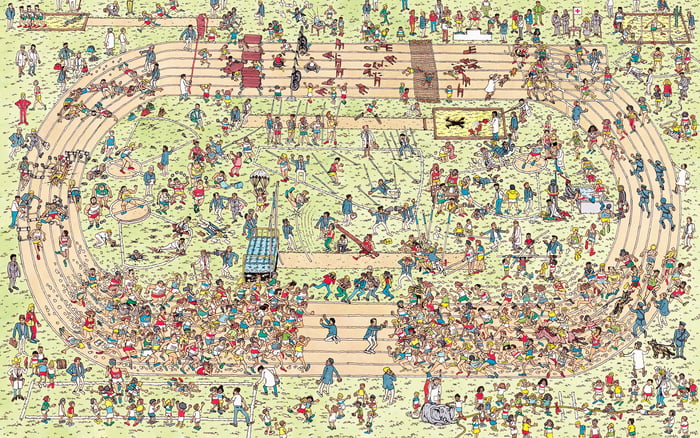
And about the US and Taiwan…
From HERE.
…the possibility of conflict between China and Taiwan, between whom tensions have been steadily rising.
Most members of the Blob, as the foreign policy establishment is called, believe the U.S. should be ready to go to war with China over the island, which escaped the Chinese Communist Party when Chiang Kai-shek and his defeated Nationalists fled there after their defeat on the mainland.
Indeed, U.S. analysts have been debating the idea of dropping Washington’s currently ambiguous stance—refusing to say yes or no—and making a clear commitment. Although the idea of not going to war is almost entirely absent in the capital, most analysts have convinced themselves that talking tough would be enough to scare off the Chinese.
"Scare the Chinese". Fools. -MM
However, Taiwan is the final Chinese territory stolen away during the “Century of Humiliation,” and even younger Chinese back their government’s claim. In such a contest angry nationalism commonly trumps good sense, as in America’s Civil War.
Americans who believe Beijing will yield its claim to Taiwan without a fight risk sleepwalking into a major war, as have so many other self-assured fools throughout history.
In any case, the president recently went off-script and declared that America would fight.
His aides quickly corrected the record, so to speak, as did President George W. Bush after making a similar promise in 2001. Nevertheless, Beijing has seen more than enough continuity between the Trump and Biden administrations toward China and assume the worst, irrespective of Washington’s verbal legerdemain.
So if the People’s Republic of China decides war is necessary and believes the U.S. will fight, the People’s Liberation Army will act swiftly and brutally, hoping to win before the U.S.—nearly 8000 miles away—can interfere.
War with China would be even worse than with Russia.
The PRC would have more at stake in the fight, local superiority, a couple score bases on the mainland roughly 100 miles away, and a victim that so far has shown little inclination to defend itself.
In combat the U.S. would have little choice but to strike the mainland, which would trigger escalation, with no obvious endpoint.
Indeed, Washington, attempting to fight from half a world away, has done poorly in wargames.
It is far easier for Beijing to deter the U.S. than for America to project sufficient power to defeat the PRC. And even a U.S. victory would probably be just the first round, as a nationalistic Chinese public prepared for round two. How much is Taiwan worth to the U.S.?
Worse, imagine if Washington faced simultaneous crises, perhaps with Iran, Russia, and China at once. While most of America’s allies discovered that they were busy, very busy, but nevertheless wished the U.S. well. Indeed, they would make a very strong statement as the bullets and missiles started flying.
President Biden has always seen himself as an internationalist. That doesn’t mean he should start a war, however. Indeed, he is one of the few policymakers who today understands the reality of war. He entered public life about the same time that the Nixon administration was pulling the last U.S. troops out of Vietnam. It has been almost a half century since America fought a conflict with heavy casualties, extended ground combat, heavy air action, and mass protest at home.
However, all could return if the administration managed to stumble into one or more major wars. At least a conflict with Russia or China would make the American people forget Biden’s ragged exit from Afghanistan. However, if he wants to be reelected—and, more important, to be a good president, however long he serves—then he should concentrate on avoiding real war with real opponents, and especially multiple conflicts at once.
It’s never a good thing.
Do something to make others happy
Like this subway artist. This gal was obviously having a bad day, but the emotion on her face says it all. video.
Oh, and don’t even think about starting a war with China or Russia
"Should there be any loss of life in the US as a result of a conflict the US federal government would disintegrate. Immediately as in ungovernable. Russia as a country has strength in the solidarity of it's people. The US and Europe not so much. A price to be paid for letting the ruling class and it's masters destroy the poor and the middle class." -So | Nov 12 2021 20:27 utc | 15
A Brief History of the Cheez-It
From HERE.
Dayton’s historic Edgemont neighborhood is cocooned inside a crook in the Great Miami River, a winding waterway that snakes through the heart of southwest Ohio. Two miles from downtown, with its air of industry, the community hearkens to a time when Dayton was hailed “The City of A Thousand Factories.”

In the early 20th century, inside a foregone factory on the corner of Concord and Cincinnati Streets, Green & Green cracker company cooked up its Edgemont product line, a collection of grahams, crackers and gingersnaps that were shipped across the region. But of the company’s four Edgemont products, only one, in particular, a flaky one-by-one-inch cheese cracker, would revolutionize snack time. On May 23, 1921, when Green & Green decided to trademark the tasty treat’s unique name, the Cheez-It was born.
“In 1921, Cheez-It didn’t mean anything, so Green & Green marketed the cracker as a ‘baked rarebit,’ ” says Brady Kress, president & CEO of Dayton’s Carillon Historical Park, a nationally recognized open-air museum centered on the city’s history of innovation. (Inside Carillon Brewing Company, a fully operating 1850s brewery at the park, costumed interpreters still bake crackers over an open hearth.) “People were familiar with rarebit, a sort of melted cheddar beer cheese spread over toast. Cheez-It offered the same great taste, only baked down into a cracker that will last.”
Cheez-It’s 11-month shelf life is impressive, but so is the company’s history. In May 2021, America’s iconic orange cracker turned 100. But the Cheez-It story stretches even further back than that.
In 1841, Dr. William W. Wolf moved to Dayton to practice homeopathy, a branch of alternative medicine that believes in the healing power of food. Hailed Dayton’s “Cracker King,” Wolf concocted the Wolf Cracker, a curious hard-butter snack made for medicinal purposes.
“In the 19th century, crackers were linked to Christian physiology and sectarian medical practitioners,” says Lisa Haushofer, a senior research associate at the University of Zurich’s Institute for Biomedical Ethics and History of Medicine. “Christian physiologists like Sylvester Graham, of Graham Cracker fame, were concerned about a modern diet that contained too many stimulating substances.” (In addition to being a cracker evangelist, Graham was also a pro-temperance Presbyterian minister who preached a vegetarian diet). Wolf echoed Graham’s concerns that food was far too rousing (though Graham also dubiously believed his crackers could cure licentiousness), so he launched the Wolf Cracker Bakery to churn out his wholesome snacks.
“They believed there was too much nourishment per food unit in modern bread, too much excitement,” says Haushofer. “So they recommended grain products made from coarse flour, which, they believed, contained a more natural ratio of nourishing and non-nourishing parts. Crackers were considered health food.”

According to Haushofer, homeopaths at the time were also concerned about digestibility, and since they believed heating food aided digestion, baked Wolf Crackers were just what the doctor ordered. But Wolf’s patients weren’t the only ones after his crackers. What started as a medical remedy soon became a sought-after treat.
In the 1870s, while living on the barren plains of North Dakota, Dayton natives J.W. and Weston Green often longed for a taste of home. “In those days food supplies were both expensive and scarce in that region,” wrote the Dayton Journal Herald in its October 31, 1907, edition, “and the father and son regularly sent back to their old home city, Dayton[,] for those necessities that could not be obtained there. ‘Invariably,’ Mr. Green says, ‘we would include in that order a good supply of … the ‘Wolfe Cracker’ [sic].”
J.W. Green never forgot the savory, buttery, nut-like flavor of Wolf Crackers. In 1897, when Wolf died, Green purchased the Wolf Bakery Company, then enlisted his son, Weston Green, to join him in business. The Greens renamed the enterprise Green & Green Company, and while Wolf’s recipe remained the same, they rebranded the doctor’s famous treat as the “Dayton Cracker.”
By the turn of the 20th century, Dayton held more patents, per capita, than any U.S. city; surrounded by this innovative environment, Green & Green flourished, expanding its operations to nearby Springfield and Lima, and delivering baked goods across southwest Ohio. But soon, the company’s crackers became more than a regional concern. During World War I, Green & Green fired up its ovens for the war effort.
“All our facilities but one little oven that can’t be used for Hard Bread will be speeded up to keep two car loads a day going by express,” read a Green & Green ad in the Dayton Daily News’s July 14, 1918, edition … “that OUR BOYS at the front may have their Fighting Bread.”

Though far less tasty than the Dayton Cracker, Dayton’s Fighting Bread sustained countless soldiers during the Great War. Typically made from salt, flour and water, Hard Bread—also known as hardtack, teeth dullers or jawbreakers—was often soaked in water before being served. If stored improperly, weevils and maggots made Hard Bread their home, prompting soldiers to dub the wartime ration “worm castles.”
“We are mighty glad and proud to be a cog in the big machine that will win the war,” read Green & Green’s ad. However, Doughboys weren’t the only ones helping win the war. “P.S. We could still use a few more women in the packing of Hard Bread.”
After World War I, Green & Green Company sidelined Hard Bread in favor of more flavorful fare. By Armistice Day, the Dayton Cracker (still made with Wolf’s original recipe) had been baked in Dayton for nearly 80 years. But while the hard butter-cracker was a local treasure, customers yearned for a delicate, flakier treat. Soon, Green & Green launched its Edgemont line, and in 1921, unveiled the “baked rarebit,” known as the Cheez-It.
“Welsh Rarebit, at its most basic form, is essentially a cheese sauce spread on toast,” says Rachael Spears, a living history specialist at Dayton’s Carillon Historical Park. “Some 19th-century English recipes specifically call for cheddar cheese. To this day, Cheez-It still advertises 100 percent real cheese, which draws a connection to its rarebit roots.”
But in 1921, Americans needed more than a novel snack. Following the Great War, the global economy dipped, and American wallets were increasingly thin. “Rarebit is a lesson in frugality,” says Kress. “It’s a nutritious dish that doesn’t cost a lot of money. When it’s baked down into a Cheez-It, it becomes a tasty treat. And just like hardtack, if you store it correctly, it will stay for a very long time. You don’t run the risk of it growing weevils.”

In 1915, one pound of Green & Green crackers sold for 10 cents, roughly $2.65 in 2021 dollars. “When Uncle Sam picked men for his army overseas,” read a June 1920 Green & Green ad, “he also picked foods that would keep those picked men robust and healthy—fit for the strenuous duties ahead of them. Just as the crackers for our soldiers kept sweet and fresh in tins, so Edgemont Crackers … keep crisp and creamy in the Family Tin. Ask mother to keep a tin in her pantry.”
Cheez-Its kept Americans fed during the post-war recession, throughout the Roaring Twenties, and at the onset of the Great Depression. But by 1932, Green & Green packed up its last Family Tin and sold the business to Kansas City’s Loose-Wiles Biscuit Company.
In 1947, the Loose-Wiles Biscuit Company became the Sunshine Biscuit Company; in 1996, Keebler acquired Sunshine; and in 2001, Kellogg acquired Keebler.
“The Cheez-It name has accompanied the baked cracker since its creation in 1921,” says Jeff Delonis, senior director of marketing for Cheez-It. “The original Cheez-It packaging was green and white. In the 1930s, red was introduced into the brand logo, and by the 1940s, the box included the iconic red and yellow-orange colors that remain today. The general shape and look of the cracker has largely stayed the same.”
Cheez-Its may still look the same, but the cracker’s production has soared. Once baked on the corner of Concord and Cincinnati Streets in Dayton’s Edgemont neighborhood, then shipped to regional grocers, Cheez-It sold more than 400 million packages in the U.S. alone in 2020.

“It’s super fun to think about all the cities around the country that were producing foods for local audiences,” says Kress. “Every city had them. Here’s an idea that came out of Dayton, Ohio.”
But “baked rarebit,” once a prevalent idiom used to describe an obscure cracker, has since faded, replaced by the now-ubiquitous term, Cheez-It.
“When you bake a cracker, you roll the dough out thin, kind of like a pie crust,” says Spears. “But at the heart, it’s like a thin, crispy biscuit. When you bite into a Cheez-It, you get those nice layers. Those are the layers that form if you cook it a bit.”
Like the Cheez-It itself, we need only bite into the snack’s history to uncover countless compelling layers.
“Cheez-It is a survivor from a bygone time,” says Kress.
Why I like Chinese girls…
A big smile. Happy times. Food. video.
A local Chinese girl shows you her life…
Sure, I make a couple of videos, but there are other people who are more photogenic than myself, and easier on the eyes. They show their life, and their food, and their homes.
Here’s one such girl. A friend. video.
American “democracy”…
China slams the US:
“The electoral democracy of Western countries are actually democracy ruled by the capital, and they are a game of the rich, not real democracy.”
I would gladly ignore this and write it off as Soviet style propaganda, were it not for some shocking statistics from Pew research poll that supports the thesis.
According to a new Pew survey published last week, many American’s seem to share concerns about the direction of the US’s democracy. The survey can be found here: (https://cnb.cx/3ooDsKw)
“Americans largely share the view that their democracy is no longer a model: 72% say U.S. democracy used to be a good example for others to follow but has not been recently.”
Frankly, I thought the number was shocking and perhaps reveals a nation tired of covid and legislative gridlock.
Pew continues with more stunning statistics from polling in 17 advanced economies:
“Few believe U.S. democracy, at least in its current state, serves as a good model for other nations. A median of just 17% say democracy in the U.S. is a good example for others to follow, while 57% think it used to be a good example but has not been in recent years. Another 23% do not believe it has ever been a good example.”
For the record I am not agitating for a change in government, nor professing undying love for China’s communism. Some will undoubtedly make these accusations.
I present this because I think it is important to acknowledge that the US’s “global brand” has been severely tarnished. Covid, Afghanistan and an assault on the nation’s capital among others are taking their toll on the US across the globe.
If it takes harsh critique from China to get the US to pay attention so be it. And it does seem to have hit a nerve , as this article is No 1 in google news search for “China” 24 hrs running. That’s why I’m running it.
China isn’t making this critique up out of the blue, they are going for the jugular and calling out a problem at least roughly supported by global sentiment. Interestingly, they don’t often criticize the US so this inflammatory rhetoric is a bit of a departure especially after progress with the climate deal.
You can see the influences of large banks or techs on the American government. Money has created enormous lobbying groups that make Banks and large industry unassailable. Big tech seems impossible to control. Whistleblowers from Meta, election interference, and consumers asking for privacy don’t seem to count for much.
Lest I get comments that I am “paid by China.” This isn’t about China but about a the real problem of money’s influence in government.
If the US’s economic rival China, sees the problem, as do American citizens, why doesn’t anyone in Washington?
Hum?
China schools compared to American schools…
Check out this little dialog. video.
And this followup. Also good. video
And, thus how it manifests for a typical Chinese family. Video.
Data Testing Julian Cope’s Dunnideer Hill Alignments Theory
A great adventure in Scotland.
It’s the story or tale of how one person took the time and effort to investigate ancient ruins in his own backyard. I applaud him, and you should too. -MM
From HERE.

In his popular guidebook to British prehistoric monuments, The Modern Antiquaria n, rock musician and poet Julian Cope proposed that a distinctive Aberdeenshire hill in Scotland, the 264 meter (866 ft) high Dunnideer Hill, formed a visual focal point of reference in the landscape in relation to the positioning of ten nearby Scottish Recumbent Stone Circles (RSCs).
Notably, no physical survey data was presented by Cope so I can only assume his comments were intuitively based, undoubtedly after physically visiting each circle and seeing for himself their collective inter-visibility with Dunnideer Hill (Figure 1). A reasonable assumption, but as an archaeologist I have to be careful when accepting such intuitively based information. More so given the fact that he used emotive language such as “Mother Earth Hill” to describe it. However, I decided to give him the benefit of the doubt and test his “inter-visible-theory” by conducting a quantifiable survey using GPS technology .

Recumbent Stone Circles (RSCs) Surrounding Dunnideer Hill
The stone circles surrounding Dunnideer Hill belong to a greater class of stone rings known as Recumbent Stones Circles (RSCs). A distinctive class of prehistoric circles which were confined to North-east Scotland.
Their architecture was consistent, set out in a ring, they often contained between ten or eleven standing stones plus an outlandishly large recumbent stone that was deliberately laid flat in the southern quadrant of the respective circle – hence their name (Figure 2). Amazingly 156 of these monuments were built across the entire landscape of Aberdeenshire.
Regrettably, only 71 of them survive today.
Carbon dating places their construction to the Late Neolithic, circa 2500 BC. The original purpose for building these stone circles remains unknown but what we can say with certainty is that no human burials have been found in any of their primary contexts.
I have already written about these RSCs in a previous article published on Ancient Origins . In that paper I proposed that a single specialist was responsible for designing every one of these RSCs.
As I also mentioned in that article, these RSCs were positioned across the landscape so that they were astronomically aligned towards each other forming clusters of circles within their respective landscape settings.
See the first of my freely available YouTube videos here explaining more about how these alignments work at the circles.
Although I had suspected that these clusters of circles were deliberately aligned towards natural features of the landscape, such as hilltop summits, I did not have any survey data to prove it.
So here was an opportunity to not only test the extent of stone circle alignments towards natural hills but also see if Julian Cope was correct.

The Ancient History of Dunnideer Hill
Of course my starting point was Dunnideer Hill. Located close to the small town of Inch, Aberdeenshire, this hill possesses its own long archaeological history.
Unfortunately, if ever a stone circle stood on the summit of this hill then whatever evidence for it is now lost.
Nevertheless, some 440 meters (1,443 ft) downslope, north-west of the summit, are the remains of the Dunnideer RSC (B), indicating that the hill was at least known to the Neolithic communities as far back as 2500 BC.
Survey Method Used at Dunnideer Hill
To survey the alignments between the Dunnideer Hill and its surrounding cluster of ten stone circles , I utilized GPS technology in the following manner. Standing on the summit of Dunnideer Hill, the GPS plotted my precise position on the ground.
This information was then relayed back to me via a positional coordinate for where I was standing.
Then systematically moving to each of the surrounding RSCs, the GPS plotted my successive positions, each time providing me with the corresponding coordinates. Using the “go to” facility on the GPS, I could then obtain the distance and direction travelled between each coordinate.
After completion I was able to cross-reference the combined GPS data to produce the maps discussed here.
What I was particularly looking for with the GPS data was to search for astronomical alignments between the hill and the surrounding ten stone circles .
Now, if I know the angle of the ecliptic (between the Sun and Earth) at around 2500 BC, I can divide that angle by the exact latitude for the hill and whichever stone circle I was standing at.
This “scientific calculation” then gives me the directions of where the Sun rose or set on the days of midwinter and midsummer for Aberdeenshire around 2500 BC.
With some adjusting (to cater for the angle of the moon’s orbit around the Earth), I could also determine similar positions for the Moon as well. After obtaining this scientific calculation I was ready to start.
The Dunnideer summit has been subjected to many alterations and much disturbance since that time. For instance, during the British Iron Age, a hill fort (circa 700 – 500 BC), was dug out across its summit. 1,500 years later, a medieval Chapel with both solid stone flooring and walling was built above the foundations of the fort, destroying anything below it.
Still, the views from the top of Dunnideer Hill are amazing (and well recommended – despite the short climb). Certainly, I could imagine the Neolithic specialist builder standing here some 4,500 years ago, viewing the landscape below, pondering where to position the ten stone circles in relation to those areas of land below being opened up for domestication and cultivation.

Dunnideer Hill Survey Results
I had established with my GPS an arbitrary distance equal to a radius of 6 km (3.72 mi.) circumnavigating Dunnideer Hill.
This radius immediately captured the ten RSCs (Figure 3). The logic behind this arbitrary distance being that (at the most) it would take an hour to walk from the farthest RSC to the hill. Secondly, all ten circles were physically inter-visible with good views of Dunnideer Hill.
Incidentally, another interesting observation uniting this cluster of circles is that they all shared similar oval-shaped large but thin recumbent stones – usually these recumbent stones are very broad and thick (Figure 4).
Possibly, these thin recumbent stones signified a specific local identity associated with this particular cluster surrounding the Dunnideer Hill.
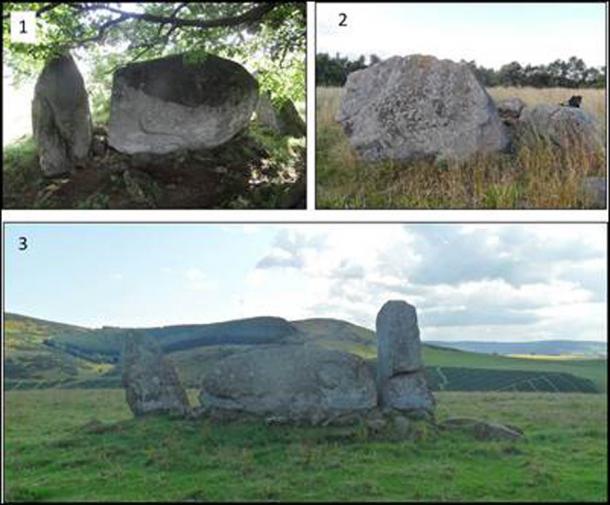
After compiling the GPS data from Dunnideer Hill, the rock musician’s theory of it being a focal point for the surrounding stone circles was proving to be disappointing. I could not find any data that would indicate that the hill possessed any astronomical correspondences towards the surrounding ten circles other than them being inter-visible with the summit.
Incidentally, Dunnideer Hill is not the only hill in this landscape, there are other hills which could have acted as alternative focal points. Nonetheless, I wanted to give Cope the benefit of the doubt, so I continued to collect GPS data from the surrounding stone circles.
As I visited each of the stone circles I needed to re-compute my original scientific calculation. When I was standing on top of Dunnideer Hill’s summit I was looking downward towards the directions of the surrounding stone circles, so the altitude factor (within my first equation) did not matter with regard to the astronomical data I collected.
Now, standing at the circles, I was looking upward, towards the summit of the hill, so I had to make the necessary adjustments for the “upward” angle of altitude.
Having made these adjustments to my second equation the results I was anticipating began to materialize but not in the manner I expected. Yes, Dunnideer Hill was important to the astronomical alignments connected with the ten circles, but it was not the single focal point as I thought it would be.
Rather than being a single point of reference in the landscape for any one of its surrounding RSCs, the data suggests that Dunnideer Hill appears to have acted like an axis mundi around which the rising and setting of both the Sun and Moon would be seen to rotate during the seasons.
And it all depended on when and where one was standing in order to see the corresponding astronomical event at each of the respective stone circles. Indeed, one would have to follow a circular route around the hill, visiting each circle at different seasons to appreciate how the Neolithic communities organized their agricultural and ceremonial calendars.
In short, they were using the hill as a gigantic beacon in the landscape to monitor the movements of the Sun and Moon. Or rather, the cosmos above revolved around the earthen-hill below, with the hill acting as the axis mundi .
Let me explain further.
In Figure 5 we see an alignment between Ardlair RSC (A), Dunnideer Hill and Old Rayne RSC (F). Taking into account the altitude factor for the hill, then the alignment runs due east / west. So let us imagine that we are standing at Ardlair RSC, looking eastward, and watching the Sun as it appears to rise behind the eastern summit of Dunnideer Hill. When the Sun appears to rise in this direction then we have an astronomical alignment between the two circles (and the hill between them).
Now, this is the alignment that would only occur on the morning of either the spring, Vernal (21st March), or autumn equinox (21st September). And vice versa, standing at the Old Rayne RSC, looking westward we can watch the equinox sunsets, setting behind the hill in the direction of the Ardlair RSC. Thus, the two circles and the hill align with the equinoxes and as such we have an ingenious method of predicting the times in the agricultural calendar for sowing (i.e. spring) and harvesting (i.e. autumn).

Similarly, in Figure 6, we can see an alignment between Wantonwells RSC (G) and Dunnideer RSC (B), with Dunnideer Hill again positioned in the middle of the two circles. The axis of this alignment corresponds to the direction of the summer solstice sunset (21st June) and vice versa the direction of the winter solstice sunrise (21st December). So if we were to stand at Wantonwells RSC and watching the sunset behind the hill then we would be looking in the direction of both north-west and the Dunnideer RSC (at the time of midsummer sunset). Such an observation might have been a cue for the Neolithic farmers to move their cattle northward, during the warm summer months, to the higher pastures around the Candle Hill RSC (D).
Alternatively, standing behind Dunnideer RSC and watching the sunrise behind Dunnideer Hill in the direction of Wantonwells RSC, then we would be looking towards the direction of the midwinter sunrise. Seeing the sunrise in this direction may have been the cue for the Neolithic communities to commence the culling of their surplus livestock which would have provided them with plenty of meat for the cold winter months.
The GPS also provided data to support the statement that the Neolithic communities were also using Dunnideer Hill as a means to monitor the movements of the Moon. For instance, the alignment between Wantonwells RSC (G), the hill and the Stonehead RSC (C) captures the setting position of the midwinter full moon at its most southerly position on the distant horizon. In effect, by using Dunnideer Hill as an axis mund i, the Neolithic communities could operate (albeit a basic) solar-lunar calendar.
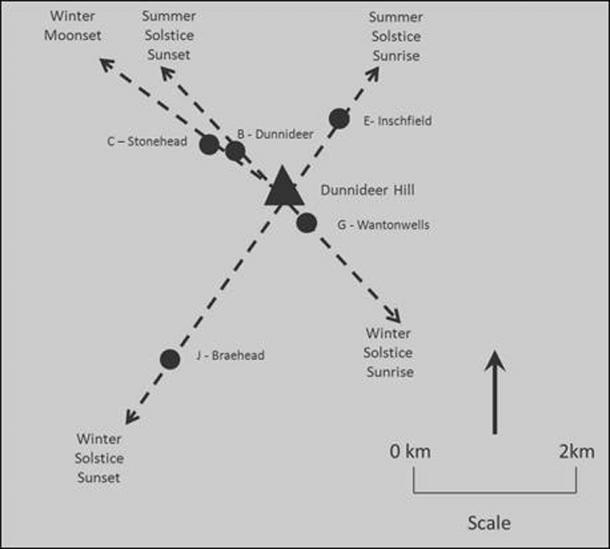
I did not want to bombard the reader with too much of the astronomy in this article, so the above examples are just a sample of the alignments I have obtained for this particular cluster of stone circles. For sure, there are many more alignments that I could have discussed here. Of course, the reader may question as to how these astronomical alignments were achieved when their inter-visibility between the stone circles mentioned here was blocked by Dunnideer Hill.
Certainly, this is an important question and in in my recent book The Recumbent Stone Circles of Aberdeenshire I propose a number of solutions. But for now, I would ask the reader to view my second freely available video which demonstrates how the geometry used to construct these circles and captured the symbolism associated with the astronomical alignments across the landscape: Ancient knowledge, Sacred geometry at the Loanhead of Daviot stone circle .
But here is another one of my solutions. That is the people were using “smoke signals” across the landscape in order to set out their stone circles in alignments (Figure 7). We have good archaeological evidence that fires were regularly set alight before, during and even after these RSCs were constructed. Although whatever the reasons for these fires remains conjectural, I can reasonably propose that they were a sure way for the Neolithic communities to set out their stone circles in straight lines across the landscape, especially when their visibility was blocked by natural hills such as Dunnideer Hill.
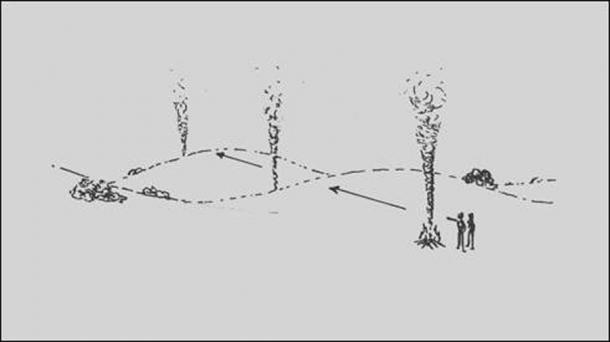
Dunnideer Hill as Axis Mundi
As well as acting as a visible focal point in the landscape, Dunnideer Hill also operated as an axis mundi for the local Neolithic communities to organize their agricultural activities. Of course, I have so far interpreted the GPS data within the practical terms of farming and there is no reason why sacred explanations could not also be offered. Social ceremonies such as weddings or funerals could have been scheduled around the hill in accordance to the relative positions of the Sun and Moon.
Indeed, at certain times of the year the solar and lunar orbs may have even been invited guests to visit the stone circles. An ethnographic analogy springs to mind here with the ancient Japanese, shamanistic religion of Shinto, which was populated by kami-spirits who lived on the summits of certain sacred hills across the Nippon landscape. The Shinto-shamans would place special stones and rocks at the bases of such hills in order to entice the benevolent spirits to come down from their summits and enjoy both the seasonal gatherings and offerings left by the people in exchange for good fortune and productive harvests.
Finally, I should thank Julian Cope for his intuitive observations. Had he not written about his ideas about the “inter-visibility-theory” between Dunnideer Hill and its surrounding stone circles then I would not have undertaken this GPS survey nor written this report.
MM video riding in the taxi on tuesday
Here’s what it’s like in my “neck of the woods”…video
I do love watching people who love their jobs…

And more about China from the Daily Stormer…
“Jewish conservatives” and shill conservatives in general have a script to inject China into everything, despite the fact that China is not running Western governments. This is partially a way to protect the people who are running our governments, by offering the distraction of a foreign enemy, but also a way to pump up anti-Chinese sentiment so that people will support conflict with them.
My goal is first and foremost to simply tell the truth. My goal is not to defend every aspect of Chinese society and culture. Politically, however, I am opposed to a war with the Chinese. Even more than that, I am against this obsession with the Chinese, which is so obviously a result of the fact that they are not on board with the globalist agenda. If you go around talking about China all the time, the only thing you are doing is shifting blame from our own leaders and feeding this drive for world government.
To the extent that I am a Chinese shill, this is the thing: as long as China is standing as an independent country, this world government cannot exist. Therefore, I am “pro-CCP” in that I am against this lunatic plan for a global tyrannical government. I also admire their strength as a people, nation, and race. How could I not admire them, when they’re the only thing standing between me and a brutal hell on earth? Furthermore, the Chinese haven’t ever done anything to me. Well, I take that back. One time I was staying at a hotel in Bangkok, and a group of Chinese tourists checked in, and they were spitting in the hallways and the elevator, so I had to switch to a different hotel. Eventually, in Bangkok, you learn that there are hotels that do not allow Chinese tourists.
But even with the spitting/yelling/cigarette-flicking – you can uncover something admirable about the Chinese. The reason that so many Chinese tourists behave in ways that we consider crude is that the overwhelming majority of the Chinese middle class are the children of literal rice farmers, who grew up in fields without electricity. Now, in one generation, their children are rich, living in a futuristic society.
China’s social credit system is a result of something called “being Asian.” The Asian social contract is totally different than the white one. No one in China other than criminals and CIA cults opposes the social credit system.
Everyone has seen this clip (regularly used by Ezra Levant), and talked about how terrible it is.
‘Social Credit Score System China’ … and how it works! 😡 pic.twitter.com/vOzt0lZphf
— daisymay4263 (@daisymay4263) October 1, 2021
But in the clip, the Chinese all say they support social credit scores. The response is “oh they’re scared not to say that.” Okay, well, we don’t see Chinese diaspora around the world opposing this system.
You can disagree with that, and I certainly would not want a social credit system in America, but nations should have self-determination.
Whining about the social credit system and supporting anti-CCP policy because of it is no different than saying that you support the war in Afghanistan because you’re against Sharia Law.
All of this stuff about how America is becoming like China is totally nonsensical.
I have a few simple questions for conservatives making these claims:
- Where are my masculinity classes for young boys? Where is my program to discourage feminism?
- Where is my nonstop propaganda about the superiority of my race, culture, and nation?
- Where is my economic program to strengthen the middle class?
- Where are my low taxes for family businesses and high taxes for large corporations?
- Where are my anti-trust laws?
Comparing the Chinese social credit system to the attempts to force this vax pass thing in the West is apples to Doritos. “We’re becoming more like China because of the vaccine passport being like the social credit system” is a shallow, stupid take aimed at people who have low IQs or are just uninformed about the world.
It’s like saying America is becoming like Afghanistan because women have to cover their faces in public because of the virus.
It’s moronic on par with Dinesh D’Souza saying that Black Lives Matter is inspired by Adolf Hitler.
The only reason someone would make an argument so obviously dumb is if they were trying to manipulate you.
I will say again that I have no specific desire to defend everything the Chinese government does. I will certainly not defend everything they have done since the revolution.
However, while I do not agree with it, the “one child policy” is very overstated by Western critics. Westerners generally have no idea at all how Asian culture works. And they shouldn’t be expected to.
I personally find it interesting, but outside of that, no one in America should be under any obligation to understand the dynamics of Chinese culture.
Unless of course, they are making judgements about them – which apparently everyone in the West feels compelled to do now.
There are many things that Westerners simply could not possibly ever understand about Asia, no matter how much information they had, simply because the historical development of the culture, and the genetics behind it, are too different.
The role of law and the concept of law enforcement is an example of something no white person is ever going to grasp.
Here’s a big think for you: during most of 2020, Christians in America were banned from attending church, while Chinese Christians were not.
In Australia, the number two country which claims to be fighting against China to create freedom, Christians are still banned from attending church.
It’s again just utterly dishonest and slimy to have these publications that express open hatred for Christianity claim that the Chinese government is at war with Christianity, while the CIA is using these home churches to incite revolution against the government.
It’s like if the CIA were using hamburger stands to traffic guns into China and the Chinese government arrested them and the New York Times ran the headline “Inside China’s Brutal Crackdown on Hamburgers” – of course, right next to “You Must Eat Bugs: Americans Have Only One Week to Stop Eating Burgers Before Cow Farts Cause Deadly Earthquake.”
By pointing to “authoritarianism,” people who are trying to demonize China can make a superficial surface level critique without any context and leap to “China is the model for the New World Order.”
The attacks on China are disorganized and weird, but they are working very well.
Frankly, I’m the only person I’m aware of that is offering meaningful analysis of the China situation in the English language, aside from a few white guys who live in China.
China is a closed society, due not to communism, but to the massive language and cultural gap.
Food cubes – Can you name them all?

And some more stuff from the Stormer…
Though it is clear that the globalist agenda hinges on regime change in China…
… that rampant anti-Chinese propaganda abounds…
… and that the entire political and military apparatus in Washington supports using the military to “defend Taiwan,” ….
… the US plan to destroy the CCP is completely unclear.
Right now, China is finally standing up and pushing back against this bullying.
If they decided to “invade” Taiwan, the Taiwanese military would put up less of a fight than the Afghan military.
Americans have no idea what is going on in Taiwan.
I would be surprised if even one soldier fired a shot if the CCP military landed in Taipei, and at least 40% of the people would openly greet them as liberators.
The people who are still against reunification in theory would just shrug, and carry on with their day.
No one in Taiwan even understands the concept of the mainland “taking their freedoms.”
No one thinks that anything substantial that affects them personally would change, other than gays and maybe some feminist women.
A lot of people want the CCP to come in and ban gay marriage.
The US forcing the gay marriage thing really rustled a lot of Taiwanese people.
Imagine the internet being flooded with videos of PRC troops landing in Taiwan and people either smiling and waving or just going about their business.
Imagine the female president of Taiwan giving a public statement apologizing to the Chinese people for “disrespectful behaviors and mean-spirited actions.”
Chuck Schumer and Ben Sasse could call a bipartisan press conference to release secret satellite photos of buildings in Taiwan that look shockingly similar to the infamous Hitler steam chambers.
They could bring in the daughter of the Taiwanese ambassador to cry and say she saw CCP soldiers eating babies.
But the jig would be up.
Seriously: what is the US going to do if China takes Taiwan? They’re going to start World War III?
I guess?
Every US military simulation about defending Taiwan from an “invasion” shows China winning, meaning the only option would be for the US to escalate.
China has consistently said they are going to fire nukes.
So we’re going to go to nuclear war for gay sex in Taiwan?
I sure looks like it.
How prepared is the US for nuclear war?
Who has been running the strategy on that front for the last two decades or so?
Mark Milley and Lloyd Austin?
Do what you can to help others.
Again, this subway artist strikes again. video.
Mysterious Carved Stone Balls Found in Scottish Isle Tomb
There’s a lot of interesting history in Scotland. Like this very curious article.
From HERE.

A 5,500-year-old tomb discovered on a Scottish island will soon be reclaimed by the sea. Archaeologists racing to excavate the site, “before it’s lost forever,” have discovered two enigmatic carved stone balls at the site.
Over the last two centuries archaeologists in Scotland have only discovered about 500 of these mysterious balls.
Dating back to between 3500 BC and 1500 BC, most carved stone balls measure around 3 inches (7.6 cm) in diameter, therefore, fitting easily into the palm of a closed hand. A 2017 Ancient Origins article explored a range of possible purposes for these stone balls.
While some archaeologists maintain they were hunting projectiles and fishing weights, others point out that most are flawless, and suggest they were sacred artifacts passed down from generation to generation.
The Press and Journal article reported that Dr Hugo Anderson-Whymark, senior curator of prehistory (Paleolithic – Neolithic) at National Museum of Scotland, posted about the discovery of the two balls on Twitter.
He pointed out that only about 20 carved stone balls dating to the Neolithic have ever been found on Orkney.
The two balls recently discovered on Orkney were described by Dr Anderson-Whymark as a “cracking find from the tomb.”
The researcher described one of the balls as “size of a cricket ball,” and that it was “perfectly spherical and beautifully finished.”
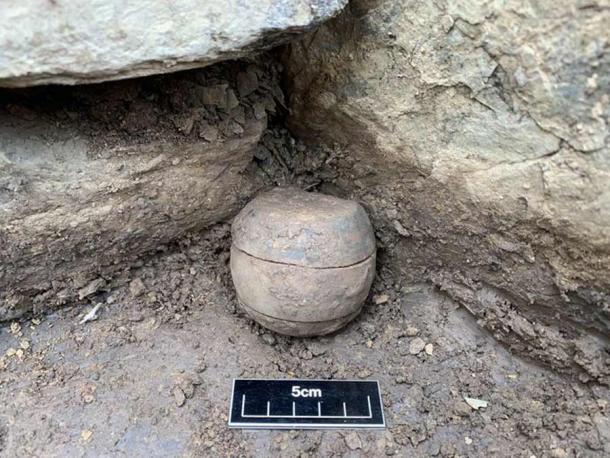
The Rare Carved Stone Balls Of Scotland: Purpose Unknown!
Carved from both hard and soft stones, most carved stone balls have six projections (knobs) but they have been discovered with as many as 160. In 1876, J. Alexander Smith suggested that when bound to wooden handles the balls would have made efficient “ axe-like weapons .”
However, in the 1970s Dorothy N. Marshall pointed out that most of the balls are nearly flawless, and that ancient people wouldn’t have spent that much time and effort on spherical accuracy for a weapon.
The most recently discovered stone balls were found on what is, arguably, the most astoundingly beautiful of the many spectacular beaches in Orkney .
Tres Ness, on the island of Sanday, is according to Orkney.com “a special place.”
The website says you will often be the only people on the beach, “soaking up the ancient scenery as if you’re on a deserted island.”
However, for the last few years the prevailing silence has been disturbed by the chinking and chipping sounds of archaeologist trowels resounding from one of the island’s Neolithic and Bronze Age settlement that is about to fall into the sea forever.

Changes Times, Changing Coast Lines
The two Orkney stone balls were discovered within a Neolithic burial tomb. According to a report in Press and Journal the tomb on Tres Ness is formally known as “a stalled cairn” where the burial space was compartmentalized.
Dating back to around 3,500 BC the burial structure represents one of the oldest remaining buildings in Scotland and it was here that a team of archaeologists found the two rare stone balls. And luckily too, as the site is quickly being clawed away by the encroaching sea .
Professor Vicki Cummings is a reader in archaeology at the University of Central Lancashire.
She speculates that the tomb at Tres Ness was probably associated with the Neolithic settlement at the Cata Sand archaeological site.
Located about a mile-and-a-half away from the Tres Ness tomb, Cummings said that both sites and the beautiful beach at Tres Ness are under immediate threat from coastal erosion .
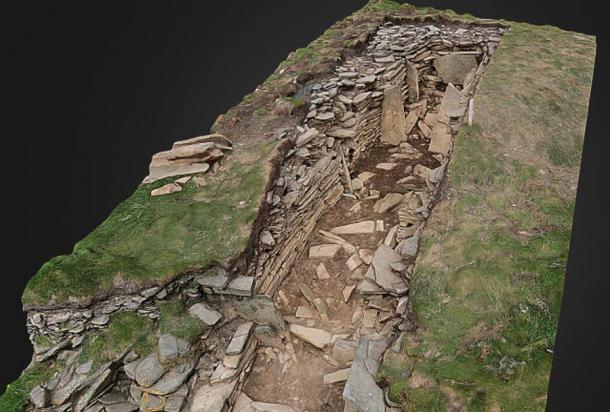
Sadly, The Sanday Orkney Site Is Vanishing Into The Sea
In the early Neolithic period both sites would have been located on a headland high above the coastline overlooking the sea from the distance and from above.
However, like sugary drinks working away at the roots of teeth, over time, the headland has been eaten away leaving the sites on the edge of a new, super-erosive, tidal coastline.
Cummings added that one major factor for the rapidly changing environment is the lack of trees, whereas in the Neolithic the entire area was wooded.
Cummings said, “sadly the site is vanishing into the sea,” so the focus of the site archaeologists is to extract as much information as possible “before it is basically lost forever.”
The discovery of the two rare carved stone balls really is what Dr Anderson-Whymark said, “a cracking find from the tomb.”
More from the Stormer…
Who is even running the US government?
Where are the adults?
The people running the US government are going around trying to force vax everyone, turn children into trannies as part of a program to normalize sex with children, and claiming that there’s a secret QAnon terrorist group planning to overthrow the government.
Then behind those freaks you’ve got freaks like Bill Gates and Klaus Schwab planning to turn themselves into genetically-engineered cyborg immortals.
Everything that is going on in the Western world is just as absurd and unserious as it is sickening and evil.
Here’s a thing which is happening: people – probably most of you reading this – are confusing the total power of the current US government for competence.
This is very natural, psychologically – it makes fundamental sense that people with absurd amounts of power would have to have competence.
But, if we break down the fact that these people inherited this power structure, then you might look at it like the logic of assuming a guy driving a Lamborghini must be rich, before you find out it was stolen.
It took me a long while to process it myself, and I definitely didn’t have a full understanding of it until Joe Biden took over as our overlord, but these people are not competent.
Upon closer inspection, we realize they are actual morons.
As a thought experiment: try to think of one single thing that the Democrats have done since assuming total domination of America that is indicative of competence.
The only thing you will likely be able to think of is the fact that they’ve managed to keep this virus thingy rolling, but that is obviously virtually entirely managed by the media.
And the success of the project is entirely dependent on the docility of the American people.
Same people, ten years later

MM home video
I took a minute to record what China is like. I was on my way to my office, and the contract of what China is compared to the crazy insanity that America is is breathtaking. It’s calm here. It’s nice and pleasant here. It’s clean, safe, relaxed, and healthy. video.
K-pop dance studios
As I have repeatedly stated in previous other articles, There’s three k-pop studios in my office building, and I often do down to watch the girls dance, make some friends, and find an opportunity to “pal around” with all the pretty girls there.
Here’s a gal performing vibrato by Stellar. video.
Some fine butt action there. LOL.
Some more from the Stormer…
China is understandably tired of having their country surrounded by the US military…
They are tired of being threatened and bullied.
And they’re tired of the humiliation of not being able to control their own internationally recognized national borders.
Yes, even the US recognizes Taiwan as a part of China…
…I guess people apparently don’t even know that.
Maybe the US will go to war, maybe they won’t – I have no way of predicting that.
I think it’s impossible to predict, given that there is no real order to the decisions being made by the people running the US government, other than that they are following this “New World Order” plot that was laid out by people who are already dead.
Most likely, if China took Taiwan, the leaders of the US would flinch, and that would signal the end of US global supremacy.
The empire would then enter into rapid decline, as without US military supremacy, there is no logic to the dollar as global reserve currency.
This would be a total tailspin, and America would look like the opening of that Dawn of the Dead remake.

It’s going to be a rough scene.
The best thing for you in such a situation would be if you – wait for it – lived in a rural community.
There will be serious rioting and all of the Walking Dead type stuff.
The blacks will probably form cannibal gangs pretty early on, but they’ll just end up eating each other. After eating his last remaining lieutenant, the last cannibal warlord in any given city will be totally alone, and his last words before he starves to death will be: “muffuggen wite ppl did dis.”
What will not happen: the Chinese will not invade America to enslave people in communism with their social credit system.
If you think that the Chinese want to invade America and enslave people, then you basically need to accept that you just don’t really have any idea what is going on.
Why would the Chinese want to invade and enslave Americans?
Just to be mean?
Do Chinese people strike you as that emotional, that they would waste huge amounts of resources in order to engage in an act of geopolitical meanness?
The entire Chinese mindset, and their entire marketing strategy as a superpower, is that they don’t invade countries, and instead trade with countries and invest in countries’ infrastructure.
There are all of these books published by Western universities over the last five years talking about how the US strategy of trying to convince countries to side with them over the Chinese was failing, and that all the countries who had made economic pacts with the Chinese were generally happy with the results.
China’s strategy has been to basically portray the US as a country of violent lunatics trying to enslave the planet with their military and their debt economic system.
And they are 100% accurate. -MM
Anthony Blinken was apparently chosen as Secretary of State because, along with being a Jewish Zionist, he’d given a bunch of speeches about the need for a new strategy to confront China in order to maintain US dominance.
It turns out he does’t have any such strategy, but he’s adamant that there needs to be a new one, which is more than the other candidates for Secretary of State were able to offer, apparently.
During his March meeting with Chinese adults, his first and thus far only major appearance on the global stage, Blinken brought a woman with purple hair and channeled Holden Caulfield when the Chinese “phonies” said that Americans need to start applying themselves to their job of maintaining world order.
America is viewed as weak by the rest of the world under the Biden administration.
Putin is challenging Biden with live debate.
And at the Alaska Summit, China told Blinken how he views America. ⬇️⬇️⬇️
pic.twitter.com/dNvSHFa0GN
— Rob Stark (@starkrob21) March 19, 2021
It’s rumored that during his interview for the job, Blinken did a pretty decent rendition of “Stairway to Heaven,” which Biden’s wife and caretaker “Doctor” Biden found “so dreamy.”
(Yes, Blinken actually was in a band and has admitted that his first choice for a career was “pop star.” Yes, he really had a single called “Lip Service,” which he wrote for Kamala Harris. Yes, that last part is a joke. I mean the Kamala Harris part. He really did release a single called “Lip Service,” which is on Spotify. This is going to go down in history alongside Caligula marrying his horse.)
Yes, after the total collapse, if you survive, then in 2050, there’s a high likelihood you will have a Chinese landlord.
Except maybe not, because if you survive the meltdown, it probably means you own rural land.
The point is: everything is probably all going to work out.
The ZOG empire is going to collapse, and the world is going to then be controlled by a Chinese merchant network, where the concept of “empire” is based on trade rather than military strength.
People will be fine in such a situation.
Certainly a lot better than we are now, under these guys.
…
In the Chinese version of Star Wars, Darth Vader has a pet triceratops.
Also, instead of blowing up Alderaan, he blows up the Kennedy Space Center.
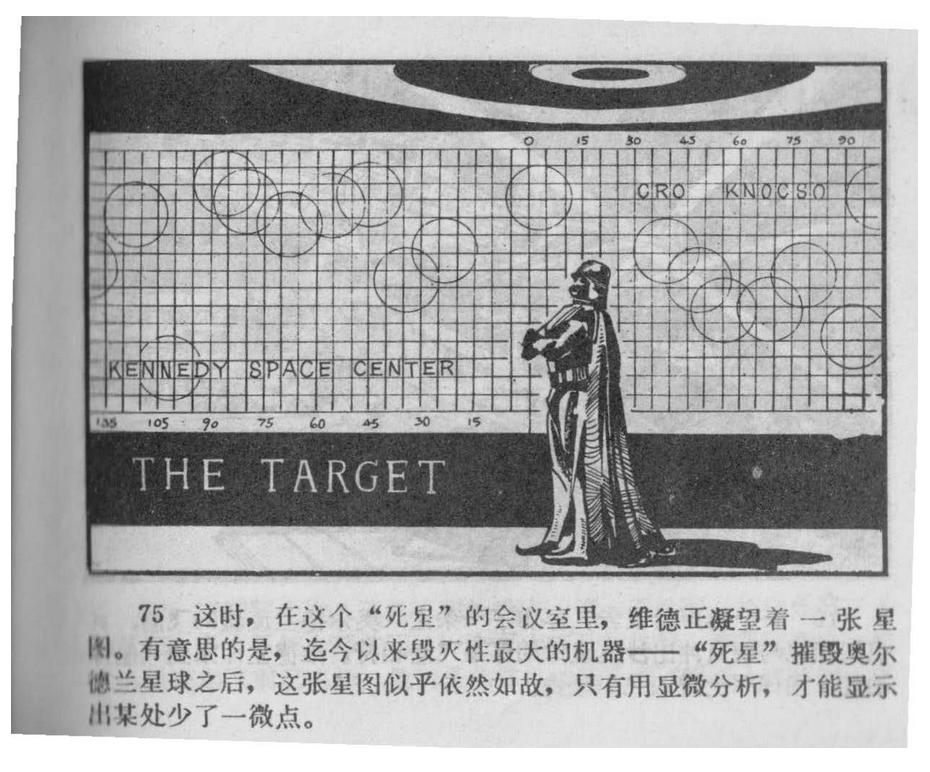
Furthermore, Obi-Wan rides a motorcycle and wears a knight’s armor.
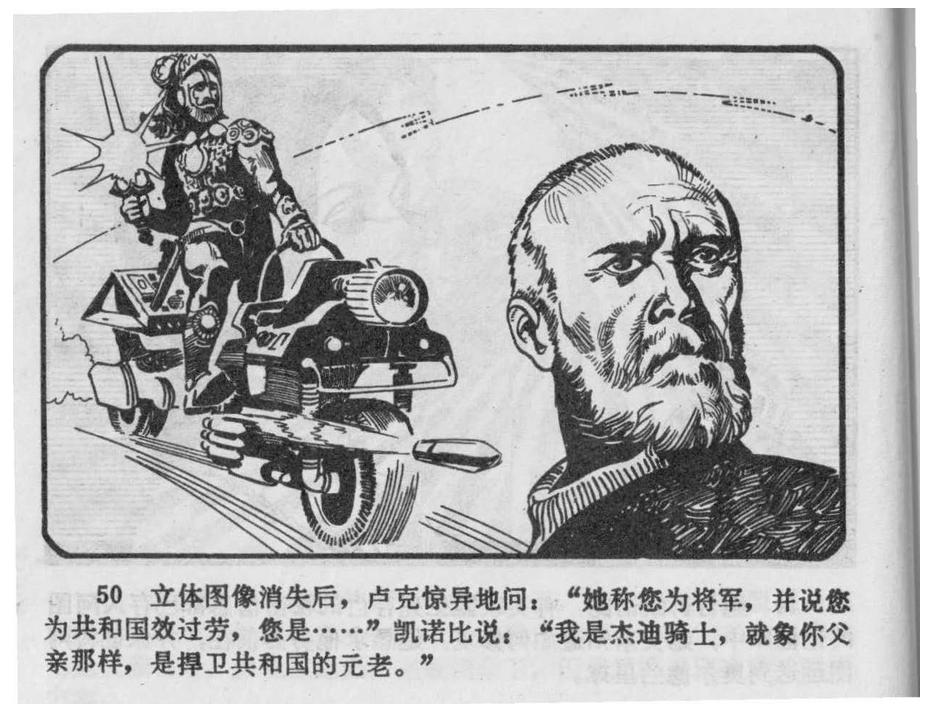
Han Solo is heavily grizzled, but he wears a heart locket.

Ask yourself: wouldn’t the new Star Wars movies have been better if instead of being about feminism and race-mixing, they explored Darth Vader’s relationship with his triceratops?
I rest my case.
Built like a fish.
In China, the idea of the perfect shape is one that resembles the smooth thin lines of a fish. Much like this girl does. video.
Or this woman who is shaped like a fish…
Nice bouncy Chinese woman. My guess is that she had implants, and the only way you can achieve such an aggressive bouncy softness is with the Motiva Ergomax implants. video. Yeah, these sixth generation implants are truly something.
It makes me want to play with her boobies. Jiggle. Jiggle. Jiggle.
China infrastructure projects.
It’s all totally under reported in the West.
Delivery guy stops and becomes a Rufus…
Just an ordinary guy, doing ordinary things, when he sees a boy drowning. In a split second he make the decision to dive in and save the boy. video
How to make authentic Pepper-pork
Here’s how you do it. It’s so easy, and OMG so very, very delicious. Give it a try, you will not regret it. video.
What it is like leaving the KTV going to the hotel…
Ah. For those of you who are not aware. This is what it is like leaving the business KTV hostess and having an evening of fun. It’s riding in the car to the hotel for the final enjoyment of the evening.
It was a fun evening. video.
Finally, Be the Rufus!
Imagine a world where everyone is nice to each other. Where families can live without worries, fear or threats. Imagine a place where everyone is helpful. Well, you don’t have to wait. You can start doing it now. Today. Just go forth and do some random acts of kindness. Smile at people. Go out of your way to be nice. Just put a little bit of sunshine in the lives of others. Be the Rufus. video.
Do you want more?
You can find more articles related to this in my latest index; A New Beginning. And in it are elements of the old, some elements regarding the transition, and some elements that look towards the future.
New Beginnings.
Articles & Links
Master Index.
- You can start reading the articles by going HERE.
- You can visit the Index Page HERE to explore by article subject.
- You can also ask the author some questions. You can go HERE to find out how to go about this.
- You can find out more about the author HERE.
- If you have concerns or complaints, you can go HERE.
- If you want to make a donation, you can go HERE.
.



